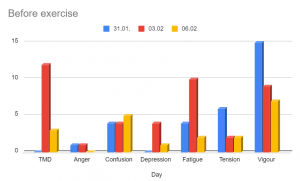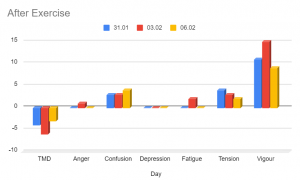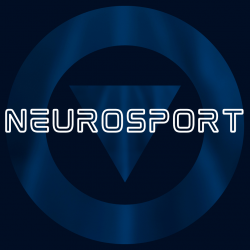Collection of the data
HRV and sleep duration was collected with an Oura ring and a sleeping diary from the Finnish Institute of Occupational Health was used in order to measure the quality. Mood state data was collected with POMS (Profile of Mood States) Questionnaire. For more information about the POMS Questionnaire, see below.
Analysis
As shown in the images, the results are from the 31st of January and 3rd and 6th of February. The exercise done during those days was divided between strength training and boulder climbing. Hence, anaerobic activity. The exercise was around 1 hour and 30 minutes long each day. As Kianian et al. (2018) mentioned, both aerobic and anaerobic exercise are helpful for decreasing anxiety and depression levels, however, anaerobic exercise has a bigger effect on it.
Analyzing the POMS results (1st picture) before exercising, I got a different value of Total Mood Disturbance (TMD) each day. But, even if there are different values, all the values are low. Compared to Laura’s values, mine are hugely lower.
The highest value in TMD was on the 3rd of February, which has the highest value in fatigue, and it was a Friday. So, due to the amount of work during the week, I probably was more tired than on other weekdays. In reference to the other values, there are few differences between them, most of the values are low.
The vigour was high on the 31st of January compared to the rest of the days, taking into account the scale of values (0-32), it is still low.
Anger and depression values are extremely low even if their scales (0-48) and (0-60) are the biggest ones on the POMS. To be honest, it is not a surprise, because I hardly ever get angry or even depressed.

As mentioned before, all the values were low compared to POMS scale or Laura’s result. However, after exercising (picture 2), those values got lower, thus my average feeling improved.
Depression feelings disappeared, anger nearly did it, and TMD values lowered every day.
My vigorous value increased every day except for the 31st of January which was the day that I one feeling most vigorous before exercising. I guess that as I trained hard, my vigour decreased due to fatigue.

Even if my POMS results before exercising were low, it is obvious that exercising helped me to be better emotionally; negative emotions decreased, and my vigour values were my highest values.
It is true that I usually leave the gym happily, but it surprised me that no matter my level of confusion or tiredness, I improve my emotional wellness.
Sleep
I knew that my average sleep duration was low, but I thought that the quality of it was good. The Oura ring’s data confirms my hypothesis. In order to analyze a long sleep pattern, I have been using the Oura ring from the 27th of January to the 10th of February.
As can be seen in the 1st picture, my average sleep duration has been 6 h and 52 minutes. However, I slept less than 6 hours, 5 times. According to the Center for Disease Control and Prevention (2023) and Hirshkowitz et al. (2015), young adults should sleep between 7 and 9 hours. I should sleep more.
Combining this data with the data about POMS mentioned before, after every day that I exercise, my amount of sleep is below my average. So, my body probably does not get enough sleep to recover from exercise. As it can be seen in the sleeping diary, the days after doing exercise were the days when I slept least. However, this is also influenced by my thight schedule.
In reference to the Heart Rate Variability (HRV) I must admit that I was not familiar with this concept. According to Myllymäki et al. (2011) exercise increases average HR however, no correlation was found between HRV and exercise. These findings are related to my data (picture 1) because there is no significant difference between the days that I have done exercises and the ones that I have not.

In order to get more clear results related to sleep and exercise bigger research should be done where Oura ring ought to be used for a longer time as well as taking notes in the sleeping diary
References:
Centers for Disease Control and Prevention. How much sleep do I need?. Centers for Disease Control and Prevention. https://www.cdc.gov/sleep/about_sleep/how_much_sleep.html
Hirshkowitz, M., Whiton, K., Albert, S. M., Alessi, C., Bruni, O., DonCarlos, L., Hazen, N., Herman, J., Adams, P. J., Katz, E. S., Kheirandish-Gozal, L., Neubauer, D. N., O’Donnell, A. E., Ohayon, M., Peever, J., Rawding, R., Sachdeva, R. C., Setters, B., Vitiello, M. V. & Ware, J. C. (2015). Natioanl Sleep Foundation’s updated sleep duration recommendations: final report. Sleep health, 1(4), 233-243. doi:10.1016/j.sleh.2015.10.004
Kianian, T., Kermansaravi, F., Saber, S. & Aghamohamadi, F. (2018). The impact of aerobic and anaerobic exercises on the level of depression, anxiety, stress and happiness of non-athlete male. Journal of Research in Medical Science, 20(1), 1-6. doi:10.5812/zjrms.14349
Myllymäki, T., Rusko, H., Syväoja, H., Juuti, T., Kinnunen, M. L. & Kyröläinen, H. (2012). Effects of exercise intensity and duration on nocturnal heart rate variability and sleep quality. European Journal of Applied Physiology, 112, 801-809. DOI 10.1007/s00421-011-2034-9

